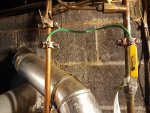ptonsparky
Tom
- Occupation
- EC - retired
Non GFCId circuits will energize that section, if it is not bonded. Short sections of piping are not required to be bonded and are not likely to be energized. At one time we were allowed to run an EG to a metallic water line when adding a receptacle to an existing two wire circuit. At that time the water line could be bonded at any point and Pex wasn't heard of. Those EG bonds to the pipe increased the likely hood of it carrying current during fault conditions and normal operation, depending on what was being used.
Safeguards would be GFCI protection and workmanship by all trades.
Safeguards would be GFCI protection and workmanship by all trades.



